Among patients seen in a primary care setting for depressive and/or anxiety symptoms, 20% to 30% are estimated to have bipolar disorder. Although relatively common in primary care settings, bipolar disorder is still underrecognized, primarily due to misdiagnosis as unipolar depression. Patients often seek treatment when they are depressed but uncommonly present with mania or hypomania, the specific markers of bipolar spectrum disorders. An awareness of the prevalence, characteristics, and predictors of bipolar disorder can help the primary care physician to properly differentiate between bipolar depression and unipolar depression. Completing a differential diagnosis of bipolar disorder requires obtaining a comprehensive patient history that investigates symptom phenomenology and associated features, family history, longitudinal course of illness, and prior treatment response. In addition to the clinical interview, the Mood Disorder Questionnaire and the World Health Organization Composite International Diagnostic Interview 3.0 can be useful tools for evaluating patients for bipolar disorder. Screening patients at risk for bipolar disorder will help to avoid the use of unproductive or possibly even harmful treatments.
Tools to Improve Differential Diagnosis
of Bipolar Disorder in Primary Care
From the Department of Family Medicine, University of North Carolina, Chapel Hill, and the Moses Cone Family Practice Residency and private practice, Greensboro, North Carolina.
This article is derived from the planning teleconference series “Improving the Recognition and Treatment of Bipolar Disorder in Primary Care,” which was held in September 2009 and supported by an educational grant from AstraZeneca.
Dr Manning is a consultant for and is a member of the speakers/advisory boards for Eli Lilly and AstraZeneca.
Corresponding author: J. Sloan Manning, MD, 4446 Ashton Oaks Ct., High Point, NC 27265 ([email protected]).
doi:10.4088/PCC.9064su1c.03
© Copyright 2010 Physicians Postgraduate Press, Inc.
Among patients seen in a primary care setting for depressive and/or anxiety symptoms, 20% to 30% are estimated to have bipolar disorder. Although relatively common in primary care settings, bipolar disorder is still underrecognized, primarily due to misdiagnosis as unipolar depression. Patients often seek treatment when they are depressed but uncommonly present with mania or hypomania, the specific markers of bipolar spectrum disorders. An awareness of the prevalence, characteristics, and predictors of bipolar disorder can help the primary care physician to properly differentiate between bipolar depression and unipolar depression. Completing a differential diagnosis of bipolar disorder requires obtaining a comprehensive patient history that investigates symptom phenomenology and associated features, family history, longitudinal course of illness, and prior treatment response. In addition to the clinical interview, the Mood Disorder Questionnaire and the World Health Organization Composite International Diagnostic Interview 3.0 can be useful tools for evaluating patients for bipolar disorder. Screening patients at risk for bipolar disorder will help to avoid the use of unproductive or possibly even harmful treatments.
(Prim Care Companion J Clin Psychiatry 2010;12[suppl 1]:17–22)
The impact of bipolar disorder on patients and on the community is substantial. Patients with bipolar disorder report more difficulties with work performance, more disruptions in social life, and more difficulties with interpersonal relationships and are more likely to report being jailed or arrested than patients without bipolar disorder.1,2 The impact continues even after syndromal recovery from a
bipolar episode, with patients, particularly those experiencing episodes with psychotic features, often not having reached functional recovery 2 years later.3 In addition,
bipolar disorder is associated with increased rates of both psychiatric and medical comorbidities,4,5 and with increased rates of mortality from diseases such as cardiovascular disease and diabetes and from causes such as suicide, homicide, or accidents.6 Patients with bipolar disorder are frequent
users of health care,7 and bipolar disorder may be the most expensive psychiatric diagnosis to treat.8
In the past couple of decades, progress has been made in recognizing the high rate of mental disorders among primary care patients. A prevalence rate of nearly 30%, when including all psychiatric diagnoses, is now accepted, with mood and anxiety disorders accounting for the majority of these diagnoses.9–11 In addition, although the community prevalence rate for bipolar disorder is about 4%,12 a large study13 (N = 1,157) in an urban general medicine clinic found nearly 10% of adult waiting room continuity patients screened positive for bipolar disorder using the Mood
Disorder Questionnaire (MDQ).14
However, bipolar disorder among primary care patients has often been underrecognized, primarily due to misdiagnosis. For example, in the general primary care population mentioned above, more than two-thirds of those who screened positive for lifetime bipolar disorder had sought professional help for their symptoms, but the majority had been diagnosed with depression and/or anxiety.13 Only 8% said they had ever received a diagnosis of bipolar disorder (or manic depression), and few of those who screened positive for bipolar disorder were taking mood stabilizers. An evaluation15 conducted in a cohort of 108 consecutive anxious and/or depressed patients in a family practice setting identified 26% of the patients as having a bipolar spectrum disorder. Similarly, Hirschfeld and colleagues16 screened a population of 649 family practice patients taking an antidepressant for depression and, using structured diagnostic interviews, estimated 27.9% of the patients as having bipolar disorder. Additionally, an investigation of consecutive
patients with difficult to treat depression and anxiety referred to a primary mood disorder clinic found that 39% had bipolar disorder.17
Recognizing bipolar disorder can be difficult, but the examination of key elements of the patient’s history via a clinical interview and the use of screening instruments can be crucial tools in the differential diagnosis of bipolar
disorder. This article will address key topics to cover in the clinical interview, as well as screening instruments for
bipolar disorder that have been validated for use in primary care.
CLINICAL INTERVIEW FOR BIPOLAR DISORDER
The Diagnostic and Statistical Manual of Mental Disorders, Fourth Edition, Text Revision18 (DSM-IV-TR) criteria for bipolar disorder require a current or past episode of
mania or hypomania. However, the most common symptom of bipolar disorder is depression, with bipolar I patients experiencing depressive symptoms more than 3 times as frequently as manic or hypomanic symptoms19 and bipolar II patients experiencing depressive symptoms approximately 39 times more often than hypomanic symptoms.20 Therefore, physicians should evaluate patients presenting with depression for possible bipolar disorder, taking into consideration not only the patient’s symptom phenomenology but also associated features, family history, course of illness, and history of treatment response (Table 1).21
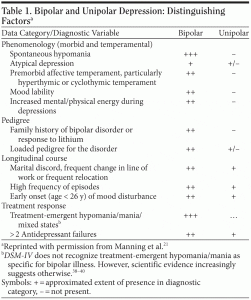
Symptoms and Associated Features of Bipolar Disorder
Certain symptoms may be more common in bipolar
depression than in unipolar depression. For instance, patients with bipolar depression more often experience atypical
depressive features such as hypersomnia, hyperphagia, leaden paralysis, and rejection sensitivity. Mood lability, psychotic symptoms, psychomotor retardation, and pathological guilt are also more predictive of bipolar depression than unipolar depression.22,23
Hyperthymic and dysthymic temperaments can be
another early presentation or predictor of bipolar disorder (Table 2).24–26 Associated features of bipolar disorder, which can be helpful clues in the absence of a clear history of a manic or hypomanic state, include multiple (> 2) divorces, tempestuous interpersonal relationships, romantic instability, use of multiple substances, an uneven employment history or frequent change in occupation, frequent change in city of residence, and legal and financial problems.2,23,25
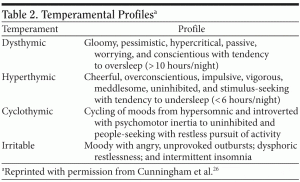
Besides major depressive disorder (MDD), bipolar disorder may also be misdiagnosed as Axis II personality disorders, typically borderline or histrionic personality disorder.27,28 For example, both bipolar II disorder and borderline personality disorder encompass irritability, impulsivity,
and affective lability. However, bipolar II disorder seems to be associated more with attentional impulsiveness (eg, inability to focus on a task; racing thoughts), while borderline personality disorder is more related to nonplanning impulsiveness (eg, inability to think through consequences of actions).29 Borderline personality disorder also appears to be associated with greater hostility than either bipolar disorder or MDD.
Family History
Family history is an informative component of the differential diagnosis of bipolar disorder. The relatives of patients with bipolar disorder are routinely more psychiatrically ill than those of patients with unipolar illness.30,31 The family histories of patients with bipolar disorder may contain multiple individuals with substance use disorders, MDD, psychosis, multiple anxiety disorders, and attention-deficit/hyperactivity disorder. The clinical interview may elicit a family history of high levels of dysfunction and aberrant behaviors that involve contact with the legal system or other negative consequences of unstable mood, such as failed marriages or work-related problems. A history of either multiple first-degree and second-degree relatives with a major mood disorder or consecutive generations with an identifiable
major mood disorder increases the likelihood that a patient presenting with depression has bipolar disorder, as does having a first-degree relative with an established diagnosis of bipolar disorder and/or a positive lithium response.31–33
Course of Illness
The longitudinal history of bipolar disorder can be confusing and sometimes misleading. Episodes of depression typically precede episodes of mania, perhaps by 5 to 10 years (Figure 1)21; this presentation can make a misdiagnosis of unipolar depression more likely. However, bipolar disorder is associated with an earlier age at onset than unipolar depression.22,34,35 A retrospective study35 of bipolar patients found that more than one-fourth of the participants experienced mood symptoms before the age of 13 years, and more than one-third experienced symptoms between ages 13 and 18 years.
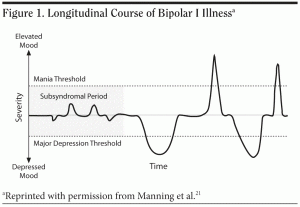
In addition to an early age at onset, the course of bipolar disorder is characterized by more recurrence than MDD.36,37 Some patients with bipolar disorder may experience a seasonal component38 or rapid cycling of episodes.36
Treatment Response
Antidepressant nonresponse may be another indicator that the patient has bipolar disorder rather than MDD. Patients who have experienced no response to 3 or more antidepressant trials for depression should be evaluated for bipolar disorder, as antidepressants typically are not effective for bipolar depression. Conversely, patients may experience an uncharacteristically rapid response, usually an abrupt mood switch soon after starting the antidepressant, as antidepressants may trigger hypomania, which can be misinterpreted as a true response but which typically is erratic, lasting only days to a few weeks. Antidepressants can also mobilize full manic episodes or even mixed episodes, in which mania and depression exist at the same time. Suboptimal responses or antidepressant-induced hypomanic or mixed states can lead to the prescription of additional medications to treat symptoms such as agitation or anxiety, and to dose increases, augmentations, or switching of agents to treat the depression, but without a stable response.39–41
SCREENING INSTRUMENTS
FOR BIPOLAR DISORDER
Once a patient’s symptoms, associated features, family history, course of illness, and treatment response have been investigated, screening instruments may be helpful tools in further evaluating and differentiating mood symptoms. Two screening instruments for bipolar disorder that have been validated in the primary care setting are the MDQ and the Composite International Diagnostic Interview (CIDI).
Mood Disorder Questionnaire
The MDQ is a patient self-report instrument consisting of 3 questions (Table 3).14 The first question is composed of 13 items describing mood or behaviors, which the patient endorses as either being present or not present during a previous period of abnormal mood. The next 2 questions establish the concurrence of any symptoms endorsed in the first question and the severity of functional impairment caused by the symptoms. If the patient endorses at least 7 of the 13 symptom items, confirms the concurrence of 2 or more symptoms during the same period of time, and rates his or her functional impairment due to the symptoms as moderate to severe, then the MDQ screen is considered positive.
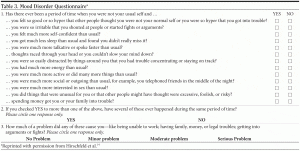
A large validation study of the MDQ was conducted by Hirschfeld and colleagues16 and included 649 patients in a family practice clinic who were receiving antidepressants for depression. Patients who screened positive on the MDQ then received the Structured Clinical Interview (SCID),42 which is administered by a trained interviewer, for diagnostic confirmation. The MDQ was found to have a sensitivity of 58% and specificity of 93% for detecting bipolar disorder in primary care, which compared favorably to an earlier validation conducted in an outpatient psychiatric setting.14
Composite International Diagnostic Interview
Another bipolar disorder screening instrument of value to primary care physicians is the World Mental Health Survey Initiative version43 of the World Health Organization CIDI 3.0 (Table 4).44,45 The CIDI 3.0 is a brief structured clinical interview with 2 stem questions that are designed to identify distinct periods of elevated or expansive mood or persistently abnormal irritable mood (ie, the DSM–IV-TR Criterion A requirement for a manic or hypomanic episode). For those patients who answer a stem question affirmatively, a Criterion B screening question then checks for associated symptoms of mania. Patients who endorse this screening question are then asked to answer 15 yes-or-no Criterion B symptom questions; those who endorse 3 or more symptoms are asked additional questions to establish episode duration, severity of role impairment, and possible organic causes.
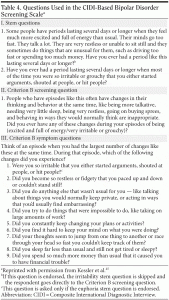
The CIDI 3.0 instrument has good discriminatory ability for the identification of bipolar disorder, depending on the number of manic symptom endorsements in the Criterion B symptom questions. A validation study45 found high concordance rates with the SCID for diagnosing bipolar disorder, with the positive predictive value of the CIDI 3.0 being 41% to 88% depending on the bipolar spectrum disorder. The CIDI 3.0 was also validated across useful subsamples of the original study group (eg, high utilizers of primary care and low-income patients). This study also identified a brief version of the CIDI using the stem questions, the Criterion B screening question, and a subset of 9 questions of the 15 Criterion B symptom questions; this brief CIDI had a positive predictive value of 31% to 52%. Administering the CIDI has the potential added value of educating the primary care physician on an effective clinical interview using questions about bipolar disorder that are highly correlated with the proper diagnosis.
Practical Aspects of Screening
Screening instruments by themselves do not make a
diagnosis, but the results are helpful when combined with the clinical interview, which elicits the key historical elements previously discussed. Using multiple screening tools might improve accuracy and correlation with the results of the clinical interview. For example, the MDQ and the CIDI 3.0 approach screening for bipolar disorder in different ways. The MDQ asks the patient to self-report previous symptoms of mania and the impairment from those symptoms in order to identify a manic episode, while the CIDI 3.0 frames the screening in terms of first identifying an episode of either significantly elevated or persistently irritable mood and then endorsing associated symptoms of mania. Individual patients and clinicians may be more comfortable with (or more responsive to) one format over the other, so using both screening instruments might be useful in the same primary care practice. Clinician confidence in the diagnosis may be enhanced when 2 screening instruments are positive and correlate with both historical elements common for bipolar disorder and the clinical interview. Conflicting information may justify consultation or referral.
CONCLUSION
In practice, an initial diagnosis may not be accurate due to myriad reasons: patient histories might be misleading or inaccurate, patients may not remember symptoms, questions may not be framed correctly, or the patient may not be receptive to the questions. A good therapeutic alliance with the patient and multiple contacts with the patient over time will foster diagnostic precision and lead to more effective and appropriate treatment.
An awareness of the prevalence, characteristics, and predictors of bipolar disorder can help the primary care physician to recognize patients that need careful screening. In addition to a comprehensive patient history, the MDQ and the CIDI 3.0 can be useful instruments for evaluating patients for bipolar disorder. In cases of diagnostic dilemmas or severe patient symptoms, primary care physicians may choose to consult with, or refer patients to, a provider in the specialty mental health care sector.
Disclosure of off-label usage: The author has determined that, to the best of his knowledge, no investigational information about pharmaceutical agents that is outside US Food and Drug Administration–approved
labeling has been presented in this activity.
References
1. Calabrese JR, Hirschfeld RMA, Reed M, et al. Impact of bipolar disorder on a US community sample. J Clin Psychiatry. 2003;64(4):425–432. PubMed
2. Stang P, Frank C, Ulcickas Yood M, et al. Impact of bipolar disorder: results from a screening study. Prim Care Companion J Clin Psychiatry. 2007;9(1):42–47. doi:10.4088/PCC.v09n0107 PubMed
3. Tohen M, Hennen J, Zarate CM Jr, et al. Two-year syndromal and functional recovery in 219 cases of first-episode major affective disorder with psychotic features. Am J Psychiatry. 2000;157(2):220–228. doi:10.1176/appi.ajp.157.2.220 PubMed
4. McElroy SL, Altshuler LL, Suppes T, et al. Axis I psychiatric comorbidity and its relationship to historical illness variables in 288 patients with bipolar disorder. Am J Psychiatry. 2001;158(3):420–426. doi:10.1176/appi.ajp.158.3.420 PubMed
5. McIntyre RS, Konarski JZ, Yatham LN. Comorbidity in bipolar disorder: a framework for rational treatment selection. Hum Psychopharmacol. 2004;19(6):369–386. doi:10.1002/hup.612 PubMed
6. Osby U, Brandt L, Correia N, et al. Excess mortality in bipolar and
unipolar disorder in Sweden. Arch Gen Psychiatry. 2001;58(9):844–850. doi:10.1001/archpsyc.58.9.844 PubMed
7. Merikangas KR, Akiskal HS, Angst J, et al. Lifetime and 12-month prevalence of bipolar spectrum disorder in the National Comorbidity Survey replication [published correction appears in Arch Gen Psychiatry. 2007;64(9)]. Arch Gen Psychiatry. 2007;64(5):543–552. doi:10.1001/archpsyc.64.5.543 PubMed
8. Peele PB, Xu Y, Kupfer DJ. Insurance expenditures on bipolar disorder: clinical and parity implications. Am J Psychiatry. 2003;160(7):1286–1290. doi:10.1176/appi.ajp.160.7.1286 PubMed
9. Regier DA, Narrow WE, Rae DS, et al. The de facto US mental and addictive disorders service system: Epidemiologic Catchment Area prospective 1-year prevalence rates of disorders and services. Arch Gen Psychiatry. 1993;50(2):85–94. PubMed
10. Mauksch LB, Tucker SM, Katon WJ, et al. Mental illness, functional
impairment, and patient preferences for collaborative care in an uninsured, primary care population. J Fam Pract. 2001;50(1):41–47. PubMed
11. Spitzer RL, Kroenke K, Williams JB. Validation and utility of a self-report version of PRIME-MD: the PHQ primary care study. JAMA. 1999;282(18):1737–1744. doi:10.1001/jama.282.18.1737 PubMed
12. Hirschfeld RMA, Calabrese JR, Weissman MM, et al. Screening for
bipolar disorder in the community. J Clin Psychiatry. 2003;64(1):53–59. PubMed
13. Das AK, Olfson M, Gameroff MJ, et al. Screening for bipolar disorder
in a primary care practice. JAMA. 2005;293(8):956–963. doi:10.1001/jama.293.8.956 PubMed
14. Hirschfeld RMA, Williams JBW, Spitzer RL, et al. Development and validation of a screening instrument for bipolar spectrum disorder: the Mood Disorder Questionnaire. Am J Psychiatry. 2000;157(11):1873–1875. doi:10.1176/appi.ajp.157.11.1873 PubMed
15. Manning JS, Haykal RF, Connor PD, et al. On the nature of depressive and anxious states in a family practice setting: the high prevalence of
bipolar II and related disorders in a cohort followed longitudinally.
Compr Psychiatry. 1997;38(2):102–108. doi:10.1016/S0010-440X(97)90089-4 PubMed
16. Hirschfeld RM, Cass AR, Holt DC, et al. Screening for bipolar disorder in patients treated for depression in a family medicine clinic. J Am Board Fam Pract. 2005;18(4):233–239. doi:10.3122/jabfm.18.4.233 PubMed
17. Manning JS, Zylstra RG, Connor PD. Teaching family physicians about mood disorders: a procedure suite for behavioral medicine. Prim Care Companion J Clin Psychiatry. 1999;1(1):18–23. doi:10.4088/PCC.v01n0105 PubMed
18. American Psychiatric Association. Diagnostic and Statistical Manual of Mental Disorders, Fourth Edition, Text Revision. Washington, DC: American Psychiatric Association; 2000.
19. Judd LL, Akiskal HS, Schettler PJ, et al. The long-term natural history of the weekly symptomatic status of bipolar I disorder. Arch Gen Psychiatry. 2002;59(6):530–537. doi:10.1001/archpsyc.59.6.530 PubMed
20. Judd LL, Akiskal HS, Schettler PJ, et al. A prospective investigation of the natural history of the long-term weekly symptomatic status of bipolar II disorder. Arch Gen Psychiatry. 2003;60(3):261–269. doi:10.1001/archpsyc.60.3.261 PubMed
21. Manning JS, Ahmed S, McGuire HC, et al. Mood disorders in family practice: beyond unipolarity to bipolarity. Prim Care Companion
J Clin Psychiatry. 2002;4(4):142–150. doi:10.4088/PCC.v04n0405 PubMed
22. Mitchell PB, Goodwin GM, Johnson GF, et al. Diagnostic guidelines
for bipolar depression: a probabilistic approach. Bipolar Disord. 2008;
10(1, pt 2):144–152. doi:10.1111/j.1399-5618.2007.00559.x PubMed
23. Swann AC, Geller B, Post RM, et al. Practical clues to early recognition
of bipolar disorder: a primary care approach. Prim Care Companion
J Clin Psychiatry. 2005;7(1):15–21. doi:10.4088/PCC.v07n0103 PubMed
24. Akiskal HS. The temperamental borders of affective disorders.
Acta Psychiatr Scand Suppl. 1994;379:32–37. doi:10.1111/j.1600-0447.1994.tb05815.x PubMed
25. Akiskal HS. Searching for behavioral indicators of bipolar II in
patients presenting with major depressive episodes: the “red sign,” the “rule of three” and other biographic signs of temperamental extravagance, activation and hypomania. J Affect Disord. 2005;84(2-3):279–290. doi:10.1016/j.jad.2004.06.002 PubMed
26. Cunningham PD, Connor PD, Manning JS, et al. Evaluation of mood disorder patients in a primary care practice: measures of affective temperament, mental health risk factors, and functional health in a retrospective, descriptive study of 35 patients. Prim Care Companion
J Clin Psychiatry. 2009;11(2):68–73. doi:10.4088/PCC.07m00575 PubMed
27. Ruggero CJ, Zimmerman M, Chelminski I, et al. Borderline personality disorder and the misdiagnosis of bipolar disorder [published online ahead of print November 3, 2009]. J Psychiatr Res.
28. Berk M, Berk L, Moss K, et al. Diagnosing bipolar disorder: how can we do it better? Med J Aust. 2006;184(9):459–462. PubMed
29. Wilson ST, Stanley B, Oquendo MA, et al. Comparing impulsiveness, hostility, and depression in borderline personality disorder and bipolar II disorder. J Clin Psychiatry. 2007;68(10):1533–1539. doi:10.4088/JCP.v68n1010 PubMed
30. Gershon ES, Hamovit J, Guroff JJ, et al. A family study of schizoaffective, bipolar I, bipolar II, unipolar, and normal control probands.
Arch Gen Psychiatry. 1982;39(10):1157–1167. PubMed
31. Wozniak J, Faraone SV, Mick E, et al. A controlled family study of children with DSM-IV bipolar-I disorder and psychiatric co-morbidity [published online ahead of print November 6, 2009]. Psychol Med.
32. Rende R, Birmaher B, Axelson D, et al. Childhood-onset bipolar disorder: evidence for increased familial loading of psychiatric illness.
J Am Acad Child Adolesc Psychiatry. 2007;46(2):197–204. doi:10.1097/01.chi.0000246069.85577.9e PubMed
33. Grof P, Duffy A, Alda M, et al. Lithium response across generations.
Acta Psychiatr Scand. 2009;120(5):378–385. doi:10.1111/j.1600-0447.2009.01454.x PubMed
34. Lish JD, Dime-Meenan S, Whybrow PC, et al. The National Depressive and Manic-Depressive Association (DMDA) survey
of bipolar members. J Affect Disord. 1994;31(4):281–294. doi:10.1016/0165-0327(94)90104-X PubMed
35. Perlis RH, Miyahara S, Marangell LB, et al, for the STEP-BD Investigators. Long-term implications of early onset in bipolar disorder: data from the first 1000 participants in the systematic treatment enhancement
program for bipolar disorder (STEP-BD). Biol Psychiatry. 2004;55(9):
875–881. doi:10.1016/j.biopsych.2004.01.022 PubMed
36. Ghaemi SN, Bauer M, Cassidy F, et al, for the ISBD Diagnostic Guidelines Task Force. Diagnostic guidelines for bipolar disorder: a summary of the International Society for Bipolar Disorders Diagnostic Guidelines Task Force Report. Bipolar Disord. 2008;10(1, pt 2):117–128. doi:10.1111/j.1399-5618.2007.00556.x PubMed
37. Goldberg JF, Harrow M, Whiteside JE. Risk for bipolar illness in patients initially hospitalized for unipolar depression. Am J Psychiatry. 2001;
158(8):1265–1270. doi:10.1176/appi.ajp.158.8.1265 PubMed
38. Shin K, Schaffer A, Levitt AJ, et al. Seasonality in a community sample of bipolar, unipolar and control subjects. J Affect Disord. 2005;86(1):19–25. doi:10.1016/j.jad.2004.11.010 PubMed
39. Bunney WE Jr, Goodwin FK, Murphy DL, et al. The “switch process” in manic-depressive illness, pt II: relationship to catecholamines, REM sleep, and drugs. Arch Gen Psychiatry. 1972;27(3):304–309. PubMed
40. Altshuler LL, Post RM, Leverich GS, et al. Antidepressant-induced mania and cycle acceleration: a controversy revisited. Am J Psychiatry. 1995;152(8):1130–1138. PubMed
41. Benazzi F. Antidepressant-associated hypomania in outpatient depression: a 203-case study in private practice. J Affect Disord. 1997;46(1):
73–77. doi:10.1016/S0165-0327(97)00082-7 PubMed
42. Spitzer RL, Williams JB, Gibbon M, et al. The Structured Clinical Interview for DSM-III-R (SCID), pt I: history, rationale, and description. Arch Gen Psychiatry. 1992;49(8):624–629. PubMed
43. Kessler RC, Ustün TB. The World Mental Health (WMH) Survey Initiative Version of the World Health Organization (WHO) Composite International Diagnostic Interview (CIDI). Int J Methods Psychiatr Res. 2004;13(2):93–121. doi:10.1002/mpr.168 PubMed
44. World Health Organization. The World Health Organization (WHO) Composite International Diagnostic Interview (CIDI). http://www.hcp.med.harvard.edu/wmhcidi/index.php. Accessed December 10, 2009.
45. Kessler RC, Akiskal HS, Angst J, et al. Validity of the assessment of bipolar spectrum disorders in the WHO CIDI 3.0. J Affect Disord. 2006;
96(3):259–269. doi:10.1016/j.jad.2006.08.018 PubMed
Please sign in or purchase this PDF for $40.00.

